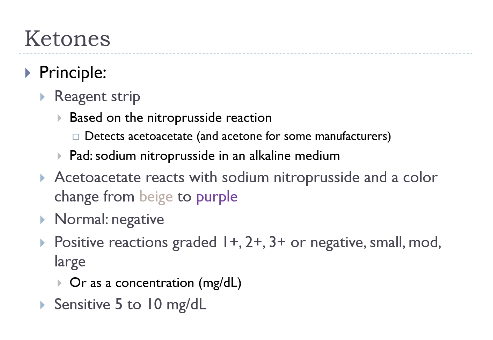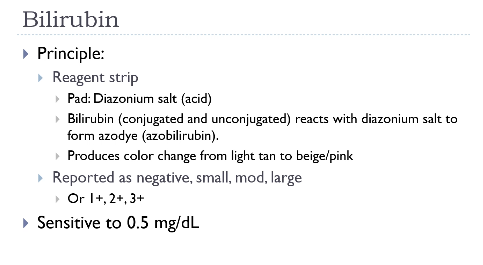Chemical Urinalysis
Lecture on Chemical Urinalysis
Introduction
Definition: Chemical urinalysis involves the use of dipstick testing to monitor and detect various diseases via urine analysis.
Purpose: Provides rapid assessment of urine for substances such as blood, protein, and glucose.
Chemical Urinalysis Method
Reagent Strips: Test strips impregnated with pads that react with urine to create a color change indicating the presence of specific analytes.
Test Components: Commonly includes tests for pH, blood, glucose, protein, and white blood cells.
Specialized Pads: Some pads are designed to test for specific analytes like microalbumin for diabetes monitoring or myoglobin for muscle breakdown.
Primordium: azo affects color. This interferes with a ton of our reagent dipstick testing because it's so highly pigmented, it literally dyes those test pads. Leukocyte esterase, nitrate, protein, ketones, bilirubin, urobilinogen, and glucose are all affected by this.
Historical Context of Chemical Analysis
Tablet Tests: Historically significant tests such as:
ACE Test: For ketones.
Ichto Test: For bilirubin.
Clinitest: Intended for children under 2 to detect reducing substances but not specific for glucose. (usually tested for galactose)
SSA precipitation test for protein.
common interference: ascorbic acid can cause false-negative results in tests for glucose and bilirubin, potentially leading to misinterpretation of the urinalysis results. Do protein electrophoresis now
Current Relevance: Though less common, tablet tests exist and are important for board examinations.
Chemical Examination Process
Specimen Requirements
Volume: Ideally, >12 mL for routine urinalysis; as low as 2-3 mL may suffice but should be referenced.
Freshness: Test urine within 2 hours, otherwise refrigerate and allow to return to room temperature before testing.
Conducting Tests
Dipping Procedure:
Hold strip and dip in urine, saturating pads without prolonged exposure.
Remove and tap to drain excess.
Timing: Varies by analyte (e.g., leukocyte esterase takes 2 minutes, glucose 30 seconds).
Reading Results: Observed in a well-lit area, oriented correctly against a color chart.
Quality Control (QC) Practices
QC Importance: Always check QC guidelines when opening new containers of strips or tablets. Daily QC testing is standard in many labs.
General QC for Reagent Strips: Ensure proper storage (dry, low moisture) and discard if damaged or past expiration.
Detailed Analysis of Analytes on Reagent Strips
1. Specific Gravity
Importance: Measures urine solute concentration, important for assessing kidney function.
Normal Range: Physiologically impossible below 1.005; indicates tampering or dilution.
Reaction Mechanism: Protons released from ionic solutes change pH, indicating concentration. PH makes the color change
high glucose: false neg
Interferences: High glucose or urea, high pH can falsely lower readings; large proteins or lactic acid can artificially elevate.
2. pH
Role in Health: Reflects kidney's acid-base balance; typically ranges from 4.5 to 8.
Testing Method: Dual-indicator system (bromothymol blue and methyl red) detects color changes according to pH levels.
Interpolation with Disease: Aids in diagnosing urinary conditions; extreme levels (e.g., >8 or <4.5) warrant investigation.
no interference/ very low
3. Blood
Sources: May indicate urinary tract disease, infection, trauma.
Detection: Both intact red blood cells (cloudy urine) and hemolyzed blood (clear urine) can be indicated. can test myoglobin( transport oxygen in muscles) as well
Reporting: Results may be reported as trace, small, moderate, or large.
Interference: Vitamin C (ascorbic acid) can mask the presence of blood in results.
based on the pseudoperoxidase activity of heme, the peroxide is reduced, and the chromogen is oxidized.
4. Leukocyte Esterase
Indicator for: White blood cells only in granulocytes, mostly neutrophils primarily indicating infection or inflammation in the urinary tract.
wont test lymphs, because not a granulocyte
This pad contains an ester and a diazem salt. What happens is that leukocyte esterase is an enzyme, so it's going to cleave the ester, form an aromatic compound or ring compound that reacts with the diazem salt to form an azo dye. And this dye changes the pad color from a beige to a violet color.
Normal Value: Typically negative; >20 white blood cells per microliter signals likely infection.
Interferences: False positives from vaginal discharge; false negatives from antibiotics like gentamicin.
5. Nitrite
Significance: Suggests presence of bacteria, particularly gram-negative rods that reduce nitrate to nitrite. most common E. Coli (gram neg rod) is the most prevalent pathogen found in urinary tract infections, making nitrite testing a valuable indicator in diagnosing such conditions.
Our nitrate reacts with that aromatic amine and forms a diazem salt. This reacts with that aromatic compound to form an azo dye.
Typical Use: Useful in identifying urinary tract infections (UTIs).
Interferences: Contaminated samples or certain antibiotics can affect results.
6. Protein
Significance: Proteinuria can indicate kidney disease; normal levels are (1-14 mg/dL).
Categories of Proteinuria:
Prerenal: Body produces excess proteins. acute phase reactants such as C-reactive protein can lead to an increase in protein levels in the urine, often seen during inflammation or infection. muttiple myeloma. too much protein, some gets through
Glomerular: Most common and serious, linked to nephrotic syndrome.
patients with hypoalbuminemia will have edema.
nephrotic syndrome: lipids in urine
Tubular: Loss due to dysfunctional tubules (e.g., Fanconi syndrome).
Postrenal: Inflammation after the kidneys, suggesting infections.
bladder infection
tests for mostly albumin
Testing Method: Uses hydrogen ions' release to indicate levels of protein.
So how do we actually measure protein on the reagent strip? The reaction method is considered the protein error of indicators. There's indicator dyes that release hydrogen ions as a result of the presence of protein. The more hydrogen ions they release, that means there's more proteins that are present and it's going to cause a more significant color change.
7. Glucose
Normal Levels: Absent in urine up to ~160-180 mg/dL plasma glucose. over 160 then it spills over renal threshold
Indicates: Often correlates with diabetes; can also suggest hormonal or organ dysfunction.
Method of Testing: Uses reagents to detect glucose oxidation which results in color change.
Talking about the clina test, also known as the copper reduction test. Again, the clina test is done to detect reducing substances. Reducing substances are things mainly, we're thinking of galactose. Sucrose or table sugar is not a reducing substance. This is a tablet test and it involves cupric sulfate to cuprous oxide and that changes the color from a blue green color to an orange color.
8. Ketones
Byproducts of: Fatty acid breakdown; seen in uncontrolled diabetes and starvation.
Testing Method: Uses sodium nitroprusside reaction; does not detect beta-hydroxybutyrate.
Normal Results: Typically negative; positive results correlate with ketoacidosis.

9. Bilirubin and Urobilinogen
uroblinigen: eurlich’s reaction

Ascorbic Acid Interference
Significance: High concentration can cause false negatives in various tests (blood, glucose, bilirubin, nitrite).
Detection Methods: Some reagent strips include a test for ascorbic acid itself to account for interference.
Reflex Testing and Result Correlation
Process Overview: Results from dipstick tests often cascade into further microscopic examinations or cultures based on specific criteria.
Importance of Reflex Testing: Saves time and ensures accurate follow-up testing based on abnormal results.
Conclusion
Summary of Key Points: This lecture provided an exhaustive overview of chemical urinalysis testing, indicating the significance of proper procedures, interpretations, and the role of various substances in affecting urinalysis results. Key tests of importance include specific gravity, pH, presence of blood, leukocyte esterase, nitrites, protein, glucose, ketones, and bilirubin. Understanding these test outcomes is crucial for monitoring and diagnosing multiple health conditions.
Recommendations: Familiarity with interaction between chemical and microscopic findings is essential for accurate clinical interpretation.
Reference Ranges for Reagent Strips
Review Chart: Familiarity with expected results is essential for proper assessment and diagnosis (recommended to reference a comprehensive guide for specifics).